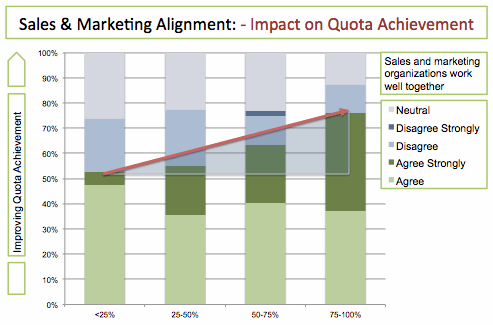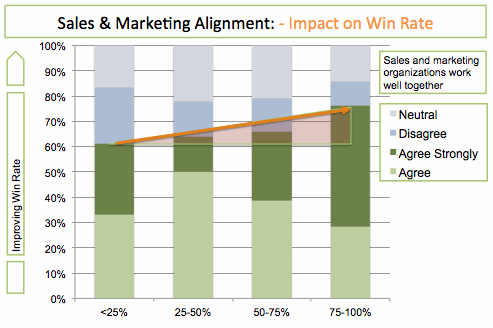In many quarters, the (mis)alignment between the sales and marketing departments is a cause of some debate, many opinions and much frustration. Apathy and anxiety are mixed in equal part, some saying that’s how it always is, and others – searching for a higher return on that ‘50% of marketing that works’ – are anxious to discover the real cost. Well, the results are in, and alignment really matters.
In fact, there can be a difference in quota attainment of up to 25% between those organizations where sales and marketing are singing in harmony, versus those where these two interdependent functions are just singing their individual tunes, more counterpoint than on point.
If you’ve been following this blog, you will know the Dealmaker Index was launched on November – and that is the source of this data. The Dealmaker Index is a free global sales benchmarking service that is free to all, where you can score your sales effectiveness relative to your peers and gain advice on how to improve. One of the areas addressed in the Dealmaker Index study is the alignment between sales and marketing.
From the chart here you can see that quota attainment is much greater at those companies where these two departments are working well together. If you’ve been agitating in your company to increase cooperation between these two functions (as I know many of you have), well here is some independent data that you may choose to use.
And of course alignment between sales and marketing is also a predictor of win rate – but far less so (about 15% delta) than overall quota achievement. In many ways this is not all too surprising – but is a little disappointing. Here the inference is that the sales person can win the deal anyway – whether supported by marketing or not, but also suggests that marketing’s input frequently stops at the top of the funnel. Marketing should be equally engaged in moving deals through the funnel, thereby impacting win rate, and overall pipeline velocity, as they are at filling the top of the funnel.
I’d love to hear whether you think the relationship between sales and marketing in your organization is truly synergistic, or if there is room for improvement. If you’ve not done so already you can also participate in the Dealmaker Index benchmark study and see how you score and rank against your peers, and see what advice you get to improve.




Informative post! Quantifying the cost of dysfunction really underscores the vital importance of sales-marketing alignment, especially now, as sales leaders are facing a 12% average increase in quota for 2012. While sales-marketing (mis)alignment is certainly not a new topic, it continues to challenge organizations because the "alignment” needed to, nurture, acquire, and retain empowered customers is different than what was called for in the past. Today, it just isn't possible to neatly demarcate the point where marketing hands off a prospect to sales—that's why we're seeing many attempts to remodel the linear sales/marketing "funnel.” It seems to me that both marketing and sales should be involved in building relationships with prospects from Day One…which is, in itself, a pretty compelling call to action for alignment. Given this, it's more important than ever for sales and marketing to agree on who their ideal customer persona is as well as how sales and marketing processes (and content) map back to specific points along the purchasing path—a pretty difficult proposition that becomes even more so when we talk about shared (vs. distinct) activities between the two teams.